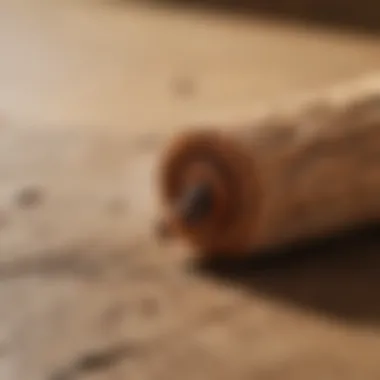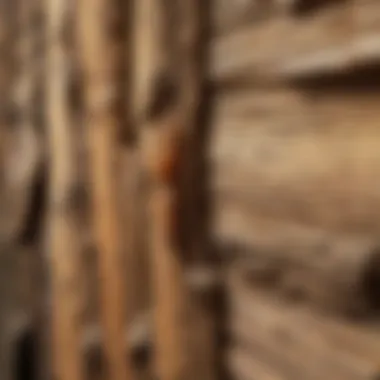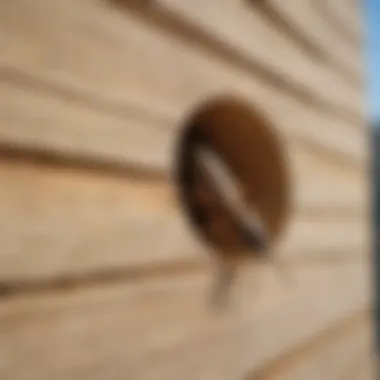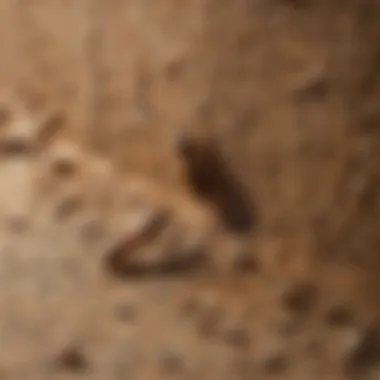Essential Guide to Termite Inspections in Bloomington, IL


Intro
Termite inspection is an essential element of home maintenance in Bloomington, IL. Understanding the nature of these pests can significantly influence the long-term integrity of a property. By knowing where to look and what to expect, homeowners can prevent costly damages caused by termite infestations. This guide will provide critical insights into termite prevention, inspection techniques, and sustainable pest control solutions that help safeguard your living environment.
Understanding Pests
Definition of Pests
Pests are organisms that negatively affect human activities. In the context of termites, they belong to the family of insects that feed on wood, paper, and other cellulose-based materials. Their capacity to destroy structural wood makes them a common concern for homeowners.
Importance of Pest Identification
Identifying termites is vital. Early detection can save significant financial resources and prevent extensive structural damage. Recognizing the signs of termite activity can aid in implementing effective control measures quickly.
"Prevention is always better than cure. Detecting termites early can save homeowners time and money."
Prevention Techniques
Home and Garden Preventative Measures
Preventing termite infestations involves a combination of structural and environmental controls. Homeowners can implement several effective strategies:
- Regular Inspections: Conduct thorough inspections in and around the home.
- Moisture Control: Address areas with poor drainage. Termites are attracted to moisture.
- Wood Management: Store firewood and timber away from the foundation of the house.
- Seal Entry Points: Close up cracks and openings in the foundation.
Seasonal Prevention Tips
Each season brings specific conditions that can either encourage or discourage termite activity. Here are seasonal tips to consider:
- Spring: Inspect for termite swarmers that may emerge. Look for mud tubes.
- Summer: Maintain yard, and remove dead trees and stumps which attract termites.
- Fall: Prepare your home by securing gaps and fissures.
- Winter: Check for signs of water leakage that might become accessible to termites when they come out of dormancy.
Eco-Friendly Pest Control Solutions
Overview of Sustainable Practices
Sustainable pest control aims to minimize environmental impact while effectively managing termite populations. Integrating eco-friendly methods supports a balanced ecosystem.
Natural Remedies and Their Effectiveness
Several natural remedies have been suggested to deter termites, although their effectiveness varies:
- Boric Acid: Acts as a stomach poison for termites.
- Orange Oil: Contains d-limonene, which disrupts termite reproduction.
- Neem Oil: A natural deterrent that can disrupt feeding patterns.
Understanding Termites and Their Impact
Understanding the nature of termites is crucial for homeowners in Bloomington, Illinois. These insects are not just a nuisance; they can significantly affect the structural integrity of homes and buildings. Knowing their biology and behavior helps in preventing infestations and mitigating damages. This section delves into the various aspects of termites, highlighting their characteristics, types, and the economic impact they have on property owners.
The Biology of Termites
Termites are social insects, classified under the order Blattodea. They live in colonies and have a complex social structure. A typical colony consists of a queen, king, workers, and soldiers. The queen can lay thousands of eggs daily, leading to rapid population growth. Workers are responsible for foraging food and maintaining the nest, while soldiers protect the colony from threats. Understanding their biology offers insights into their behavior, particularly in foraging and nesting, which are critical when planning termite prevention strategies.
Types of Termites Common to Bloomington
Bloomington is home to several termite species. Each type poses different risks and requires unique approaches to inspection and management.
Subterranean Termites
Subterranean termites are among the most destructive wood-destroying pests in the U.S. They typically live underground in soil. Their key characteristic is their ability to create extensive networks of tunnels, which provide them with access to wood and moisture. This ability makes them a popular focus for pest control discussions. The unique feature of subterranean termites is their strong preference for moist environments, which makes early detection crucial. Neglecting signs of their presence can lead to severe damage in structures, necessitating expensive repairs.
Drywood Termites
Drywood termites, unlike subterranean species, do not need contact with soil. They thrive in dry wood, making them a potential threat for wooden structures such as furniture and frames. Their key characteristic is the ability to infest hardwood, which is why they are especially concerning for homeowners. One unique feature of drywood termites is their reproductive capacity, as they can establish colonies in isolated pieces of wood. Detection can be tricky, often leading to undiagnosed infestations until significant damage occurs.
Formosan Termites
Formosan termites are an invasive species, originally from Asia. They are known for their aggressive nature and high reproductive rate. The key characteristic of this type is their ability to build large colonies, often much larger than any native species. This makes them a high threat for homeowners. A unique feature of Formosan termites is their ability to survive in a variety of environments, making them very adaptable. The implications of their infestations can be severe, requiring prompt action and professional intervention due to the extensive damage they can cause within a short period.


The Economic Cost of Termite Damage
The economic implications of termite damage are staggering. Homeowners in Bloomington may face costs in the thousands of dollars. Not only does this involve the immediate repair of structural damage, but also the expenses associated with prevention and ongoing monitoring. Long-term, undetected infestations can lead to decreased property value and can complicate future sales. Investing in regular inspections and informed pest management strategies can ultimately save homeowners significant amounts of money and protect their investments.
The Importance of Termite Inspections
Termite inspections play a crucial role in protecting properties from the potentially devastating effects of termite infestations. In Bloomington, Illinois, homeowners must understand the significant benefits of regular inspections. The presence of termites can lead to structural damage that may not be visible until it is too late. Regular inspections can prevent this damage, saving homeowners substantial costs in repairs. Additionally, these inspections foster peace of mind by ensuring a safe living environment, free from these destructive pests.
Early Detection of Infestations
Early detection is one of the most important reasons for conducting termite inspections. Termites often operate silently, causing damage invisibly within walls and foundations. A professional inspection can unveil signs such as mud tubes, which indicate termite travel routes, or wood damage, where termites have feasted extensively. If an infestation is discovered early, homeowners can address it promptly, limiting damage and costs. Timely intervention can be the difference between minor repair work and a major structural overhaul of a home.
Preventative Measures
Inspections also play a vital role in preventative measures. By identifying risk factors, such as high moisture areas or wood-to-soil contact, homeowners can take proactive steps to minimize the likelihood of an infestation. Strategies may include improving drainage, sealing cracks, or using termite-resistant materials during construction or renovation. These preventative ideas can greatly enhance the longevity of a home and protect against future infestations.
Local Regulations and Insurance Implications
Understanding local regulations regarding termite control is another important aspect of inspections. In Bloomington, there may be specific laws that govern how infestations are handled and reported. Being aware of these regulations ensures that homeowners remain compliant and avoid potential fines. Moreover, homeowners’ insurance may have stipulations regarding termite damage. Regular inspections and reports can assist in navigating insurance claims, protecting the homeowner’s financial interests. By remaining informed about these implications, homeowners can better safeguard their properties.
Regular termite inspections not only prevent damage but also provide significant insights into maintaining the health of your home, ensuring its value is preserved for years to come.
Preparing for a Termite Inspection
Preparing for a termite inspection is a crucial step in maintaining the health of your home. Termites, often dubbed the ‘silent destroyers’, can cause significant damage before their presence is even detected. An inspection allows homeowners to catch these pests early. Understanding what to expect during an inspection and how to choose qualified professionals enhances the efficacy of the process. Knowing your responsibilities as a homeowner further contributes to a successful inspection.
Choosing a Certified Pest Inspector
When selecting a pest inspector, it is essential to prioritize certification and expertise. Certified pest inspectors have undergone rigorous training and are familiar with local termite varieties and their behaviors. Check for credentials such as those from the National Pest Management Association or local Illinois pest control associations. Additionally, asking for referrals from friends or neighbors can provide insights into the inspector’s reliability. A qualified inspector will conduct thorough checks, utilizing various methods to ensure no infestation goes unnoticed.
What to Expect During an Inspection
Understanding the inspection process to expect can alleviate much of the preparation stress. An inspection typically lasts from one to two hours, depending on the property size and complexity. The inspector will examine areas prone to termite infestation, such as basements, crawl spaces, and wooden structures. They may use tools such as moisture meters or thermal cameras to assist in finding hidden problems. Homeowners should be prepared to follow the inspector and ask questions regarding findings.
Homeowner Responsibilities
Homeowners play a vital role in the inspection process. Prior to the inspection, it is beneficial to tidy the property and clear any debris around the foundation. This allows the inspector easy access to critical areas. Furthermore, maintaining transparency about previous pest control efforts or known issues can aid in a more accurate assessment. After the inspection, be open to recommendations provided by the inspector, as these suggestions will help you manage or prevent potential infestations effectively.
"Maintaining a proactive stance can save homeowners from the costly repairs associated with termite damage."
By preparing appropriately for a termite inspection, homeowners can mitigate risks and ensure their properties remain safe from these hidden invaders.
Inspection Methods and Techniques
When it comes to termite inspections, employing the right methods and techniques is crucial for accurate detection and subsequent treatment. This guide emphasizes the significance of various inspection methods, highlighting their specific benefits and considerations. Understanding these techniques allows homeowners to better protect their properties against potential infestations.
Visual Inspection
Visual inspection serves as the foundation of any termite inspection. This method involves a thorough examination of exposed wood, cracks, and voids in structures to identify signs of termite activity. Inspectors typically look for mud tubes, which are pencil-sized tunnels made by subterranean termites, as well as signs of damaged wood.
Inspectors often check around foundations, basements, and crawlspaces. Key points of attention include:
- Wood Damage: Look for soft or crumbling wood. Sounding wood with a hammer can help reveal hollowness which signals infestation.
- Shelter Tubes: Mud tubes can often be found in garage door frames or near foundation walls.
Visual inspections are a critical step because they are non-invasive. They help pinpoint areas that may require further assessment or immediate action. Regular visual inspections can reduce the chance of extensive damage.
Moisture Meters
Moisture meters play a vital role in detecting potential termite trouble. Termites thrive in environments with high moisture levels. Therefore, measuring moisture content in wood and in the surrounding areas becomes an integral part of the inspection process.
Moisture meters can indicate issues such as:
- High Moisture Content: Levels above 20% often signal vulnerability to termite infestations.
- Hidden Leaks: Identifying damp areas can help prevent infestations before they start.
Using moisture meters along with visual inspection can provide a comprehensive assessment. It allows inspectors to focus on high-risk areas during further evaluation.


Termite Detection Devices
Advanced termite detection devices enhance the inspection process significantly. These electronic tools can locate termite infestations that may not be visible during a standard visual inspection.
Some commonly used devices include:
- Acoustic Emission Detectors: These can pick up sounds made by termites as they eat through wood.
- Infrared Cameras: These capture temperature differences in walls and structures, revealing hidden infestations.
These devices add a layer of precision to the inspection methods. They can help in identifying infestations before extensive damage occurs. Although these tools are beneficial, they should be used in conjunction with traditional inspection methods.
Chemical Treatments and Bait Systems
While not strictly an inspection method, understanding chemical treatments and bait systems is essential in managing detected infestations. After a thorough inspection, effective treatments help to mitigate termite problems effectively.
- Liquid Treatments: These involve applying chemical barriers around the perimeter of a home. They can provide significant protection against future infestations.
- Bait Systems: These systems are placed in the ground and attract termites. Once they find the bait, they carry the poison back to the colony, effectively reducing population numbers.
Implementing these treatments post-inspection ensures that identified infestations are controlled. It also prevents new ones from taking hold, ultimately preserving the integrity of your home.
Effective inspection methods, such as visual inspections, moisture meters, and advanced detection devices, set the groundwork for successful termite management.
These techniques together form an essential strategy for safeguarding homes against the persistent threat of termites. Engaging professional pest inspectors who utilize a combination of these methods can ensure comprehensive evaluations, allowing for prompt responses to prevent significant damage.
Signs of Termite Infestation
Detecting termite infestation early is essential to minimize damage to your property. Homeowners must be vigilant in observing the signs of these pests. Termites can cause significant financial loss, and recognizing their presence is the first step towards prevention and control. In this section, we will explore the common signs that indicate a termite problem, focusing particularly on mud tubes, wood damage, and swarmers with wings.
Mud Tubes
Mud tubes are one of the most telltale signs of termite activity. These structures are about the width of a pencil and are typically found leading from the ground up to the wooden parts of your home. They serve as protective highways for subterranean termites, allowing them to travel safely while maintaining moisture.
When you notice mud tubes, it is critical to investigate further. The presence of mud tubes often means that termites are actively feeding on the wood in your home structure. Homeowners should look for these tubes in basements, crawl spaces, and along foundation walls. Removing a piece of the tube carefully can help you ascertain if termites are still present; however, it’s often wise to consult a pest control professional for a thorough assessment and proper treatment.
Wood Damage
Wood damage is another crucial indicator of termite infestations. Termites eat wood from the inside out, which makes the damage difficult to detect until it is quite severe. Hollow-sounding wood is a symptom of termite activity, and if you tap on any wooden structures and hear a dull thud instead of a solid sound, further inspection is warranted.
When inspecting for wood damage, pay attention to key areas such as:
- Floor joists
- Wooden beams
- Door and window frames
Additionally, you might find small holes or frass (termite droppings) near damaged wood. If such signs are present, immediate action is necessary to prevent worsening damage. Replacing damaged wood can be costly, so addressing the issue promptly can save time and money.
Swarmers and Wings
Swarmers are mature reproductive termites that leave their nest to mate and establish new colonies. The presence of swarmers or discarded wings is a strong indicator of an existing infestation. Typically, swarmers appear during the warmer months, usually in the spring.
Homeowners should keep an eye out for the following signs:
- Swarming activity indoors, usually around windows and light sources.
- Piles of wings near windowsills or in other areas of your home.
If swarmers are found inside your home, it suggests that a nearby termite colony is established and could be threatening your property. Immediate measures should be taken to contact a pest control professional to evaluate the situation and recommend appropriate action.
Early detection of these signs can save homeowners considerable repair costs down the line.
In summary, recognizing the signs of termite infestation is essential for homeowners. Identifying mud tubes, wood damage, and swarming activity can help prevent the costly consequences of severe infestations. A proactive approach to monitoring these signs will aid in maintaining a termite-free home.
Post-Inspection Procedures
After a termite inspection is conducted, homeowners must navigate the crucial phase of interpreting the results and deciding the next steps. Understanding the outcomes of the inspection is essential, as it sets the foundation for treatment options and long-term strategies against termite infestations. This section delves into the necessary actions and considerations following an inspection, highlighting the importance of an informed approach.
Interpreting Inspection Results
Interpreting the results from a termite inspection can seem daunting, but it is a vital part of effective pest management. A certified pest inspector will provide a detailed report which outlines any signs of termite activity, the extent of damage, and potential concerns for the structure. Homeowners should pay close attention to recommendations made in the report.
Common indicators include visible damage in wood, signs of mud tubes, and other structural anomalies. Understanding these results enables homeowners to prioritize immediate treatment versus long-term monitoring.


It is important to ask the inspector any questions regarding unclear aspects of the report.
Effective Treatment Options
Once the inspection results are clear, selecting an appropriate treatment becomes essential. There are several effective methods to consider: liquid treatments, bait systems, and fumigation.
Liquid Treatments
Liquid treatments involve applying a pesticide in liquid form directly into the soil around and beneath the building. This method is effective for creating a barrier that prevents termites from accessing wooden structures. One of the main advantages of liquid treatments is their ability to offer immediate protection and long-lasting results.
Homeowners appreciate this method due to its straightforward application and visible results. However, it's essential to note that continuous monitoring is necessary to ensure the barrier remains intact, especially after heavy rainfall.
Bait Systems
Bait systems are another strategic approach to termite control. They consist of bait stations strategically placed around the property. These stations contain materials attractive to termites laced with a slow-acting insecticide. When workers take the bait back to the colony, it affects other termites, including the queen.
The key characteristic of bait systems is their environmentally friendly nature, providing targeted control with minimal impact on non-target organisms. One disadvantage is that results may take longer to observe, as it relies on the termites to consume the bait over time.
Fumigation
Fumigation is a comprehensive treatment method. It involves sealing the entire structure and filling it with a gas that penetrates all wood areas, effectively eliminating termites. This method is advantageous for severe infestations, especially in cases where other treatments may not be effective.
The unique feature of fumigation is that it allows for treatment of hard-to-reach areas in the structure. However, homeowners should be aware of the necessity for relocation during fumigation, as the process requires temporary evacuation for safety reasons.
Long-Term Monitoring Plans
After treatment, establishing a long-term monitoring plan is vital to prevent future infestations. Regular inspections can help catch signs of termite activity before they escalate. Here, homeowners should consider scheduling annual check-ups with pest control professionals and implementing preventative measures around the property, such as maintaining a dry environment to deter termite attraction.
Creating a proactive mindset towards termite management not only preserves the integrity of the home but also offers peace of mind for homeowners.
Eco-Friendly Approaches to Termite Management
Adopting eco-friendly approaches to termite management is essential for homeowners looking to protect their property and the environment. These methods aim to reduce the reliance on harmful chemicals while still effectively controlling termite populations. Eco-friendly practices not only promote a healthier living environment but also align with growing sustainability concerns. In Bloomington, IL, where termite infestations can be prevalent, understanding these approaches can make a significant difference.
Biological Control Methods
Biological control methods involve using natural predators or pathogens that target termites. This approach is effective and minimizes adverse effects on the ecosystem. Some common biological control methods include:
- Nematodes: These microscopic roundworms invade and kill termites. They can be applied to the soil around a structure, targeting subterranean termites.
- Fungi: Certain fungi, such as Beauveria bassiana, can infect termites. Homeowners can introduce specific fungal spores to affected areas.
- Ants: Some species of ants naturally prey on termites. Enhancing their habitats in yards can help control termite populations naturally.
Implementing biological control methods requires careful planning and knowledge of local ecosystems. It is crucial to choose methods that fit within the context of Bloomington's unique environment.
Preventative Landscaping Techniques
Landscaping can play a crucial role in termite prevention. Homeowners can adopt several practices to reduce the risk of termite infestations:
- Remove Wood Debris: Keeping the yard free of dead trees, stumps, and wood piles can minimize termite habitats.
- Maintain Drainage: Ensuring proper drainage around the property can reduce moisture levels, making the environment less attractive to termites.
- Use Mulch Wisely: While mulch is beneficial for gardens, using it too close to the foundation can invite termites. Consider using alternative materials like gravel instead.
- Plant Vegetation Wisely: Certain plants can deter termites. For example, adding plants such as marigolds around the house can be beneficial.
These landscaping techniques not only help deter termites but also enhance the overall appearance of a property. Homeowners should consider integrating these methods into their ongoing yard maintenance as a proactive strategy against termite infestation.
Adopt eco-friendly approaches to pest control not only assures a safe home environment but also contributes toward a sustainable future.
By employing biological control methods and preventative landscaping techniques, homeowners in Bloomington can effectively manage termite populations while minimizing their ecological footprint. Implementing these practices reflects a commitment to both property protection and environmental stewardship.
Culmination: Importance of Regular Inspections
Regular inspections for termites are crucial in protecting your home from potential damage. Termites can cause significant economic loss if they infest structures without detection. Early identification of termite activity not only prevents expensive repairs but also reduces the stress related to unexpected infestations. The cost to repair termite damage can amount to thousands of dollars. Thus, having a routine inspection can be viewed as a prudent investment rather than an additional expense.
Homeowners should consider that termites often work silently. They may invade a property for months or even years before any noticeable signs emerge. A regular inspection schedule enables quick intervention, which can mitigate or entirely halt further damage. Inspections are especially significant in neighborhoods where termite activity has been reported. Knowledge about local infestation trends helps owners stay vigilant.
Factors influencing the inspection schedule may include the age of the home, proximity to wooded areas, and historical termite activity in the locality. For instance, houses built on or near termite-prone zones may benefit more from frequent inspections. Another factor is the climate; warmer areas typically see higher termite activity levels.
Benefits of Regular Inspections
- Early Detection: Identifying termites at the early stage avoids extensive damage.
- Cost Savings: Prevents high repair costs associated with significant termite damage.
- Peace of Mind: Knowing that your home is safe from termites reduces anxiety.
- Insurance Compatibility: Some insurance policies require proof of regular inspections for termite coverage.
"Prevention is better than cure." Regular inspections foster a proactive stance against potential termite problems.
In Bloomington, IL, homeowners have access to various pest control services offering inspection packages. By selecting a certified pest control service, homeowners can ensure thorough assessments. Even if no signs are found, regular inspections contribute to peace of mind and knowledge of one’s home environment.
In summary, the importance of regular termite inspections cannot be overstated. They provide protection, save money, and ultimately preserve the integrity of your home. By remaining observant and diligent, homeowners can manage the threat of termites effectively.



